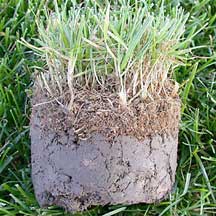What is Thatch and How do You Deal With It?
As part of a regular lawn care program, it is recommended to check your lawn for dense layers of roots and decaying plant matter which resides between the grass plant and the soil, also called thatch, which causes thinning and makes the lawn more susceptible to disease and weeds. While a normal layer of thatch will protect the crown of the grass plant and prevent soil compaction, heavy thatch buildup will prevent rain and fertilizers from penetrating the thatch layer. This robs your lawn of the water and nutrients needed to grow a thick and healthy turf.
Checking for thatch in your lawn
You can check for thatch by lifting a section of the lawn and measuring how much decaying matter there is and where the roots are in relation to the soil. One-fourth to ½ inch of thatch is considered about right.
Controlling lawn thatch
Water for optimal root growth
 Proper lawn care eliminates thatch.
Proper lawn care eliminates thatch.
© Purdue University
One of the biggest contributors to thatch is poor lawn care, including improper watering or applying too much quick release nitrogen fertilizer. These practices encourage excessive growth.
Watering or irrigation methods are key to preventing thatch. Watering frequently, but not deeply, encourages roots to stay on the surface rather than growing deeply into the soil. Infrequent, deep watering encourages good root development.
Deep, full grass roots keep lawns thick and green, protect them from drying out, and prevent weeds from taking hold. Water about ½ inch twice a week or 1 inch a week. Place a small can on the lawn and start watering. When the can has the desired amount of water, stop watering. If you have an automatic irrigation system, make sure it is programmed correctly for your lawn’s needs.
Mower clippings
Despite the common perception, allowing grass clippings to remain on the lawn does not contribute to thatch. Grass clippings decompose rapidly, adding nutrients to the soil. Clippings longer than 3 inches should not be left on the lawn, however, because they may smother the grass.
Aeration, raking and lawn care
The best way to get rid of thatch is regular aeration and good lawn care practices. Aeration should be done every year or two, depending on the severity of the thatch, the condition of the lawn and how much foot traffic there is on the grass. Aeration can be done in spring or fall.
Raking also is an option for removing thatch. You can use a regular garden rake to pull out the dead grass and thatch. This is hard, time-consuming work and recommended only for small sections. For larger areas, power or mechanical rakes are available for rent or purchase. And, while these are efficient and quick, you need to be careful not to damage the grass that is healthy or tear up the soil.
Regular aeration reduces or eliminates the need for raking thatch. Make sure to set the mechanical rake’s controls properly. Once the thatch is removed, the lawn may not look good. Overseeding to fill in bare or thin spots in the lawn may be needed.
To prevent thatch buildup, use a high quality, slow release nitrogen fertilizer, such as a GreenView Fairway Formula Fertilizer, and mow to keep the grass about 3 inches tall.